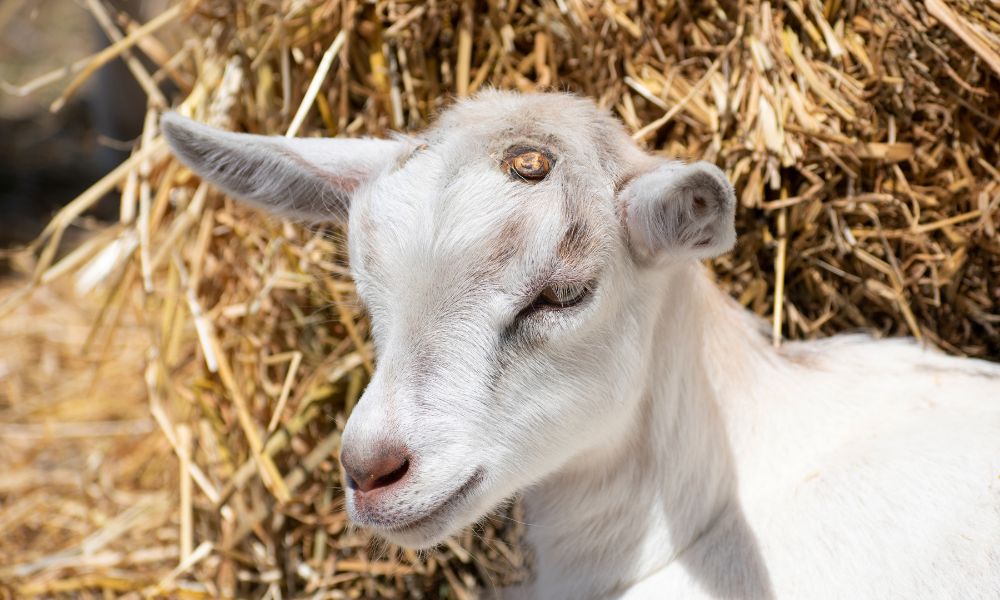Disbudding is a fairly simple process to understand, then, and has been carried out on goats for a very long time.
Horns can in a number of ways be problematic for goat handlers, especially for breeds with very large horns.
Equally, many worry that the process is harmful and unethical.
Let’s look further into this.

Why do you disbud goats?
Generally, disbudding is done to make goats easier to handle in a large-scale farm environment.
If you have many horned goats that need to be wrangled for one reason or another, it can naturally make it a lot easier if they don’t have an offensive weapon to use against you.
The size of the goat’s horns is going to play a big role in the decision to do this.
Many popular meat breeds are very large, and thus they have equally large horns to compliment.
When you have a large goat with large horns, they’re harder to handle.
Generally, though, this is to increase efficiency in large-scale operations.
Goat owners who keep them as pets and companions do not typically do this, as there is really no reason to do so.
For those who are worried about safety, they may wish to disbud their goats at home.
However, there are plenty of reasons, for the goat’s health, not to do so.
It would do you better to simply look into breeds with naturally shorter horns.
There are no goat breeds that are naturally polled or disbudded—they will all have horns.
But some are much larger than others.
How is the process carried out, then?
How do you disbud goats?
The process is a very simple one.
You have to do this within the goat’s first few days of life, though, otherwise it will not work and will only wound the goat.
You use a hot iron, specifically a tool called a disbudding iron.
You must then grip the goat’s muzzle firmly so it will not move around—this could cause serious injury.
Then you apply the hot iron to the goat’s horn buds, holding it down for around 8 seconds, and rocking it around slightly.
Make sure the kid remains immobilized.
As you can see, this is a rather distressing experience for the goat—so does it hurt?
Does it hurt to disbud a goat?
The short answer is yes.
Having a hot iron applied to your head, especially at such an incredibly young age, is a highly distressing thing for a goat to go through.
The goat will most likely experience shock as a result, and this alone may be enough to kill it.
Other common concerns are thermal damage to the cerebral cortex, and neurological disease as a result.
Disbudding can permanently damage a goat’s brain, making it disabled for life.
It is important to carry it out at the right age.
If you do it too soon, then you stand a very high chance of killing the goat.
Too late, and you won’t disbud it, you’ll just cause its horns to grow deformed.
So, yes, applying a hot iron to the sensitive part of a goat’s head will cause it pain.
Disbudding has more than a couple of applications, but unless you absolutely need to, it’s really best to avoid doing this if you can.
The main problem is not being able to get a professional to carry out the procedure.
Do vets do disbuddings?
Generally, in the modern day, vets will not do disbuddings.
They may have at one time, but it is largely considered unethical veterinary practice today.
That said, there are people who will carry out the service for you.
But they won’t usually be vets, just someone who has experience disbudding.
This is, as I said, one of the main issues with disbudding.
It’s a very sensitive and potentially damaging procedure, and it’s very difficult to get it right without experience.
The cost of getting it wrong is incredibly high.
If you can find someone you trust to carry out the procedure, great.
If you want to do it yourself but you’re even slightly unsure of what you’re doing, my advice would be to look really hard at why precisely you want to disbud your goat.
So, whether or not you want to disbud your goats is dependent on a few things.
As an ordinary goat owner, keeping goats as companions and not needing to handle large numbers of them, you’re probably fine without disbudding them.
There are many potential risks involved with disbudding, especially given that specialists will often not perform the procedure.
Ethically speaking, it is a painful and distressing thing for the goat to go through.
Avoid disbudding unless you really need to.
